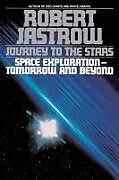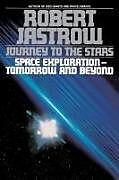Journey to the Stars
Einband:
Kartonierter Einband
EAN:
9780553349092
Untertitel:
Space Exploration--Tomorrow and Beyond
Autor:
Robert Jastrow
Herausgeber:
Random House Publishing Group
Anzahl Seiten:
230
Erscheinungsdatum:
19.08.1990
ISBN:
0553349090
Autorentext
Robert Jastrow
Klappentext
Robert Jastrow discusses the past and future of space exploration, the cosmic mysteries that still await solution, and the possibility of extraterrestrials whose intelligence far outstrips our own.
Leseprobe
Introduction
If intelligent beings exist in space, and they look in our direction now and then, they will have observed something in recent years that must pique their curiosity. At television and FM frequencies, our planet blazes more brightly in the sky than the sun itself. For the first time in the history of the Universe, the earth has become a conspicuous object in the heavens—a beacon sending signals to every nearby star that intelligent life has arisen on this planet.
Some astronomers believe no intelligent beings exist on these stars to receive our message. They believe mankind is alone in the Universe. But other astronomers are unwilling to accept that conclusion. They do not find it credible that, out of all the billions of planets in the Universe around us, only one should have been touched with the magic of life.
These astronomers point to the fact that the Universe is 15 billion years old, but the sun and the earth are only four and a half billion years old. It follows that if other solar systems contain intelligent life, this life must, on the average, have evolved at least a billion years beyond mankind.
Reflecting on the fact that the human brain has doubled in size in the last million years, the astronomers say to themselves: Beings whose evolution has carried them a billion years beyond the human level may possess great heights of brainpower; how interesting it would be to speak to them, and find out what they have learned in that long interval. The greatest thinkers in human history might be as children in their presence. “In their eyes,” one observer suggests, “Einstein would qualify as a waiter and Thomas Jefferson as a busboy.”
How long must we wait before we are admitted to the company of these stimulating creatures? If the extraterrestrials exist, our television signals have made them aware of our presence; but perhaps they find our thoughts too simple to warrant a response. Perhaps another billion years must pass before the mature beings of the Cosmos judge mankind’s descendants worthy of their attention.
It seems a pity that we must wait so long for the interesting exchange to begin. But this reasoning may underestimate the curiosity the advanced extraterrestrials might display in such new arrivals as Homo sapiens. Intelligence and curiosity go together; the discovery of new worlds may be life’s greatest pleasure for a highly intelligent being. It is difficult to avoid a suspicion that the advanced beings—if they exist—have visited the solar system at least once in all those billions of years. And having visited once, would they not return now and then, to find out how the garden is growing?
In fact, reports of such visits appear regularly in the press. However, my feeling about these reports is one of doubt, because the beings that appear in UFO reports usually seem too humanlike to match a scientist’s expectations for a form of life so far beyond mankind that it can cross the void between the stars. The extraterrestrial visitors are nearly always described as “humanoid.” They differ from humans in size and detail, but always have the same basic design—made of flesh and blood, and with four limbs, two grasping appendages and a talking head.
Yet forms of life like this appeared on the earth only a few hundred million years ago. In the perspective of the 15-billion-year history of the Cosmos, that is a short time. It is possible that extraterrestrials visiting our planet will happen to be within a few hundred million years of the human level of development, but that is not very likely. Most life in the Universe—if other life exists—is either several billion years beyond us in its evolutionary state, or several billion years behind us. Such creatures, removed from mankind by billions of years of evolution, will not resemble us in any way.
The history of life on the earth provides a hint of the changes evolution works in the forms of life during a billion years. Life began on our planet about four billion years ago. A billion years later, it had evolved to the stage of bacteria and other one-celled organisms. Two billion years after that—and now the time is one billion years ago—evolution had reached the level of soft-bodied animals resembling the worm and the jellyfish. These creatures were the highest forms of life on the earth a billion years ago. In the last billion years of evolution, the fossil record tells us, the wormlike animals evolved into humans.
With this knowledge, derived from the fossil record and from the astronomical evidence for the antiquity of the Universe, what can we expect for the nature of life in other solar systems? If that life is a billion years behind mankind, it is likely to be at the level of the wormlike creatures which represented the most advanced organisms on the earth one billion years ago. In that case, this life could not have mastered the technology needed for the journey to our solar system. And if the life on another world is a billion years older, it is as far beyond us as we are beyond the worm—so far evolved beyond mankind as to bear no relation to humans in body, mind or desires. This line of thought leads me to the conclusion that extraterrestrials arriving at the earth from another star are likely to be so different from the kind of life we know that we may not recognize them as living creatures when we see them.
This is the perspective, then, that science affords on mankind’s place in the Cosmos: While we stand at the summit of creation on the earth, in the cosmic community of intelligent life we are among the children of the Universe. As we take our first steps into space, and reach out to cosmic life through our television and radar signals, it is my sense that the most momentous developments in the history of life on this planet may be about to unfold.
1
The Moon Beckons
November 1957: Eve of the anniversary of the Russian Revolution. The scene is engraved in my memory. Three scientists came out of the Vanguard control center in Washington—the heart of America’s ill-fated satellite project. The moon was full. Two days before the Russians had launched a dog into orbit. Rumors flew; they would hit the moon and mark it with a splotch of red dye. Red and white—could we add a patch of blue? Nobody laughed. We couldn’t reach the moon; we couldn’t even get our rockets off the pad. The Russians had captured high ground; we could not follow.
December 1957: I am standing next to John P. Hagen, director of the Navy’s Project Vanguard, America’s first attempt to launch a satellite. I can still see the ravaged look on his face when the call came in from Cape Canaveral saying that the Vanguard rocket had risen 4 feet off the pad, fallen back, and collapsed in a sea of fire. Newspaper headlines around the world shouted “Flopnik” and “Kaputnik.”
Two months earlier, on October 4, the Soviets had launched Sputnik I, a 184-pound ball of polished metal. This first artificial satellite circled the earth every hour and 35 minutes, 560 miles up, sending a steady stream of radio beeps back to earth. The launching was a tremendous source of pride for the Soviet Union. An editorial in Pravda made the point: “The Sputnik is a victory of Soviet man.… It has again been p…

Leider konnten wir für diesen Artikel keine Preise ermitteln ...
billigbuch.ch sucht jetzt für Sie die besten Angebote ...
Die aktuellen Verkaufspreise von 6 Onlineshops werden in Realtime abgefragt.
Sie können das gewünschte Produkt anschliessend direkt beim Anbieter Ihrer Wahl bestellen.
Loading...
Die aktuellen Verkaufspreise von 6 Onlineshops werden in Realtime abgefragt.
Sie können das gewünschte Produkt anschliessend direkt beim Anbieter Ihrer Wahl bestellen.
| # | Onlineshop | Preis CHF | Versand CHF | Total CHF | ||
|---|---|---|---|---|---|---|
| 1 | Seller | 0.00 | 0.00 | 0.00 |
